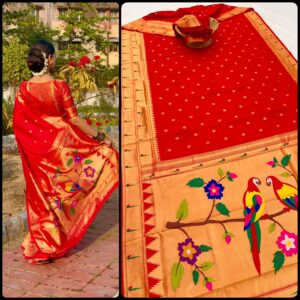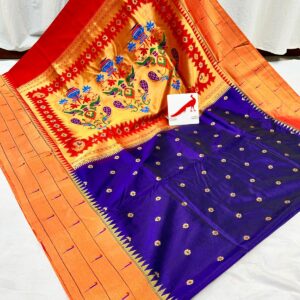Triple Munia Paithani
Showing all 2 resultsSorted by latest
Double Muniya Border Paithani
₹1,550.00 Select options This product has multiple variants. The options may be chosen on the product pageSemi Silk Tripple Munia Paithani
₹4,550.00 Select options This product has multiple variants. The options may be chosen on the product page
Triple Munia Paithani : A Timeless Indian Weaving Tradition
Introduction to Triple Munia Paithani
The Triple Munia Paithani saree showcases intricate craftsmanship and the rich heritage of Indian weaving traditions. Known for its unique patterns and vibrant colors, this saree is named after the “munia” or parrot motifs woven into the fabric. It symbolizes opulence, grace, and cultural heritage, making it a prized possession for women across India.
History and Legacy
Origin and Evolution
The Paithani saree originated in the town of Paithan in Maharashtra during the Satavahana dynasty around 200 BCE. Initially, weavers used pure silk and gold threads to create these sarees, reserving them for royalty and the affluent. Over centuries, the craft of Paithani weaving evolved, incorporating influences from different regions and dynasties. The Triple Munia Paithani emerged as a distinct variation, characterized by its triple parrot motifs and intricate border designs. This evolution reflects the adaptability and resilience of traditional weaving practices passed down through generations.
Symbolism and Significance
The Triple Munia Paithani holds deep cultural significance and symbolism. The munia or parrot motifs represent nature, beauty, and prosperity. In Indian culture, parrots often symbolize love and devotion, adding an element of auspiciousness to the saree. The vibrant colors used in Triple Munia Paithanis bring positive energy and happiness to the wearer. Women often wear these sarees during significant occasions such as weddings, festivals, and religious ceremonies, symbolizing the continuity of tradition and cultural heritage.
Craftsmanship and Technique
Creating a Triple Munia Paithani saree requires the expertise and dedication of skilled weavers. The process begins with selecting the finest silk threads, which artisans dye in vibrant colors using natural dyes. Traditional wooden looms interlace the threads to create the complex designs that define the Paithani. This craftsmanship not only preserves an ancient art form but also supports the livelihoods of artisans who continue to uphold this tradition.
Distinctive Features of Triple Munia Paithani
The Munia Paithani stands out for its distinctive features. The presence of triple parrot motifs arranged in a row adds unique charm to the saree. Additionally, the saree features a rich and elaborate border, often adorned with floral patterns and geometric designs. The pallu, or the end piece of the saree, showcases intricate zari work, demonstrating the weaver’s skill in handling metallic threads. Vibrant and contrasting colors enhance the beauty of the Paithani, making it a standout piece in any wardrobe.


